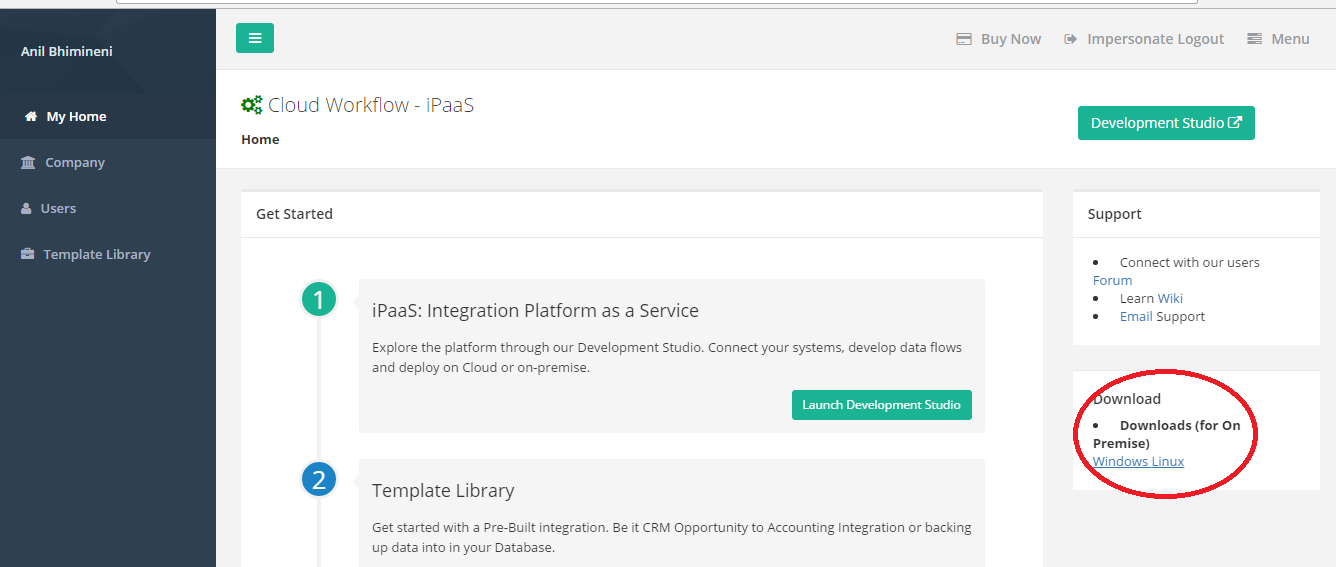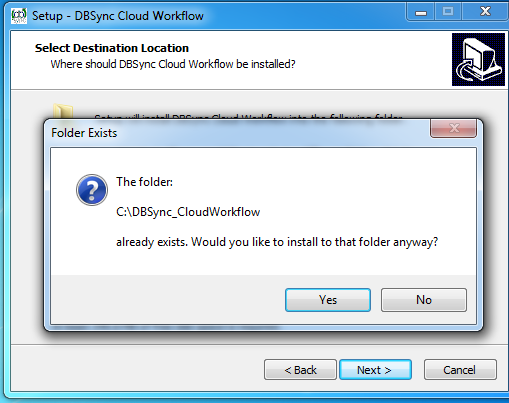2022
Page History
Backing Up Projects
Before you upgrade to the latest version of DBSync's On-Premise mode, it is a best practice to back up all your integration projects that you created using earlier versions. Even though the installer does not purge your existing 'db' folder during an upgrade, as a precautionary action, take the following steps to backup your data.
- Go to My Computer and navigate to the DBSync installed directory. By default the directory is (C:\DBSync_CloudWorkflow ) unless you selected a different directory to install an earlier version of DBSync <<DBSync Install Dir>> \dbsync2\WEB-INF\conf\db
- Copy all the files and folders of "db" folder to your designated directory or drive.
- For example, if DBSync is installed on the default path chosen by DBSync installer - which is "C:\DBSync_CloudWorkflow" - your local database path will be "C:\DBSync_CloudWorkflow\dbsync2\WEB-INF\conf\db".
Download Latest Installer
You can download the latest version of DBSync Cloud Workflow from the DBSync App center/DBSync landing page as shown in the image below. Follow the listed steps to download the installer.
By default, the installer is downloaded to the "Downloads" folders of the logged in user of the system. The installer is named "DBSync_CloudWorkflow_VX.X.X.X" following the naming convention i.e. the first part "DBSync_CloudWorkflow" specifies the product line of DBSync and the second part "VX.X.X.X" specifies the version of the downloaded installer.
Go to the DBSync website www.mydbsync.com. Navigate to My Account - > Customer Login.
Input Inputting a valid DBSync platform platform Email ID and and password - to login to into the DBSync App-center/Platform . This will take the user to - will land a user on the landing page.Click
To save the installer to your "Downloads" folder, click on the the download link - as highlighted in on the image to get the installer to your "Downloads" folder.Here, you have an option to download the above image.
Based on your needs, download a desired operating system version that suites your needs - Linux or Windows.
Uninstall Earlier Version
Before you want to upgrade to the latest version, Be be sure to uninstall to earlier version of DBSync cloud workflow that - assuming one is already installed on your machine - of DBSync cloud workflow. Follow either one of the two approaches, listed below steps , to uninstall the DBSync from your machine.
First way Approach:
- Navigate to Control panel → Programs → programs & Features from your computer
- On the windows from the list choose "DBSync_CloudWorkflow_VX.X.X.X"
- you can right click on the program which will show you uninstall, Clicking on uninstall will open a windows pop up asking whether "Are you sure you want to completely remove DBSync cloud workflow and all of its components"
- Click on Yes button to proceed with uninstall and progress bar will show the progress.
- After the uninstall , A windows pop up opens saying "DBSync Cloud workflow was successfully removed from your computer". Now click on OK button to confirm.
Second Way Approach:
Alternatively, you can uninstall it from the startup programs by navigating to startup programs → DBSync Cloud Workflow → uninstall and continue with the uninstall that process. This will remove DBSync, and all of its components from components, from your file system.
DBSync Cloud Workflow Installation
For upgrading the To upgrade DBSync Cloud workflow you will have to , uninstall the earlier version as detailed out in the earlier sections of this article and - following the steps listed above - and then, install the newer version as explained in the following steps.
- Start the installation by right-clicking on the installer and chose "Run as Administrator" option which would . This will start the installation process.
- Sometime the windows Windows might not allow you to install on your file system, If "User Account Control" window is popped pops up then, click on on the Yes button to authorize the windows Windows to proceed with the installation.
- NowNext, you will be on see the "License Agreement" screen, make . Make sure to you select the option "I Accept the agreement" and click on the Next button to proceed with the installation.
- The default installation path is shown as "C:\DBSync_CloudWorkflow". If you wish to choose a different folder then, click on the Browse button and select the desired location to proceed with the installation.
- If you have installed the an earlier versions version of DBSync for evaluation purpose, the installer detects will detect the installed directory and alerts as shown in the imageshown an alert as displayed below.
- Choose the option Click on "Yes" if you wish to install the new version to the earlier installed directory, Else choose option . Or else, choose "No" to change the installation directory.
- On the "Select Additional Task" windowscreen, check the check options (1) "Create a desktop Shortcut" and, (2) "Create a Quick Launch shortcut" if you wish to have place DBSync shortcuts on your desktop, and quick launch panel, on your desktop respectively. click Click on the "Next" button to proceed with the installation.
- From the "Ready to Install" window, Click on click on the Install button to proceed with the installation and . The progress bar on the bottom of the "Installing" window will show you display the progress status of the installation process.
- Once the installation process is complete, you will be on window with name a screen named "Setup - DBSync Cloud Workflow" having . Here, you will have an option to "Set DBSync as service".
- If you wish to set it as a service, check the Check box "Set DBSync as Service" and click on the "Finish" button as illustrated in the following image.
- If you have selected select the option 'Set DBSync as Service', then DBSync would be running will run as a Windows Service in the background.
- If you wish to start DB sync DBSync manually, you can start DBSync do so from your desktop by starting clicking "Start\All Programs\DBSync CloudWorkflow\DBSync".
Launch DBSync through All-Programs
If you wish to start the DBSync from the program files - either after the installation or at any other time you login to your machine , - you can go to Start->All Programs->CloudWorkflow CloudWorkflow and choose DBSync service which would . This will launch the tomcat that would acts tomcat. Which, in turn, will act as DBSync application server on the machine it is installed.
Now from your web-browser tab type the following address http://localhost:8080/cw/login.m?username=localhost_165@avankia.com&sessionId=avankia1&loginType=password&productCode=SomeCode to launch DBSync locally.
you You can also learn the different options available of the installed about different available options listed in the installed folder of DBSync Cloud workflow, . The following table shall list out lists all the available option for you to perform the necessary actions.options:
| Features | Description |
|---|---|
| DBSync | DBSync service which would will launch the tomcat that would acts tomcat. This in turn will act as DBSync application server on the machine it is installed |
| Remove Service | Choosing this option would will remove the service from the windows services which runs in the background. Go to Control panel→Administrative Tools→ services Look for the service Apache Tomcat 8.5 DBSync which is removed. |
| Set as Service | On the start up of the windows, Instead of starting the service every time you can choose the option Set as Service that would run the service in the background. Go to Control panel→Administrative Tools→ services Look for the service Apache Tomcat 8.5 DBSync that keeps running. |
| Stop Service | Stop Service will stop the DBSync service |
| Uninstall | Uninstall will remove all the DBSync cloud workflow components from your machine. |


